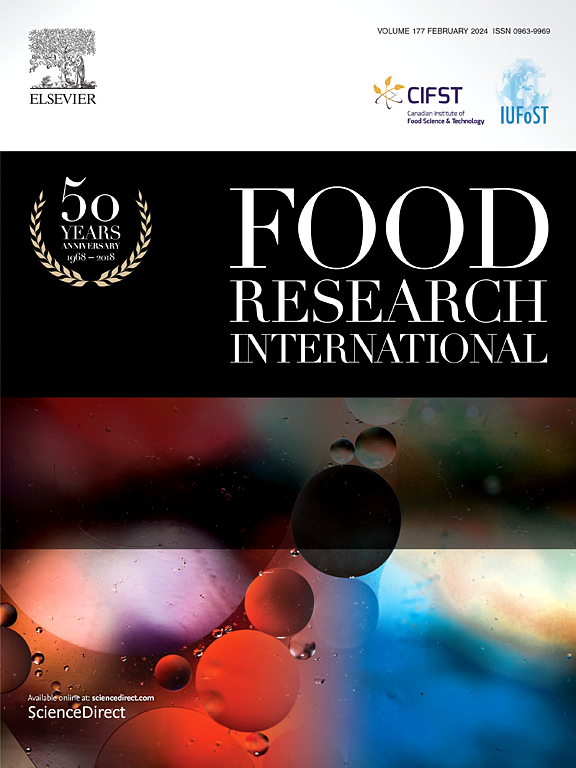结合生物信息学技术研究牦牛乳干酪中两种新肽的抗炎活性
IF 7
1区 农林科学
Q1 FOOD SCIENCE & TECHNOLOGY
引用次数: 0
摘要
背景:牦牛乳酪蛋白肽具有良好的抗炎活性,但其抗炎机制和特异性分子靶点的研究还存在空白。目的:本研究旨在阐明两种新的牦牛酪蛋白衍生肽QEPVLGPVRGPFP (QP13)和VYPFPGPIPN (VN10)的抗炎机制,这两种肽是先前通过生物信息学筛选发现的。方法:采用lps诱导的RAW264.7巨噬细胞模型,以吲哚美辛为阳性对照,在浓度为187.5 ~ 1500 μg/mL的条件下进行多肽评价。分子对接和100 ns分子动力学模拟分析了与关键炎症靶点:诱导型一氧化氮合酶(iNOS)、肿瘤坏死因子-α (TNF-α)和白细胞介素-6 (IL-6)的相互作用。结果:在1500 μg/mL时,VN10和QP13对巨噬细胞无毒性,对一氧化氮(NO)的产生(分别为90.44±0.88%和87.58±0.88%)、TNF-α(分别为67.56±3.94%和60.32±1.72%)和IL-6(分别为80.87±0.52%和67.02±1.38%)的抑制作用最大。两种多肽在抑制NO方面均优于吲哚美辛。分子对接揭示了与iNOS、TNF-α和IL-6的关键残基(Trp-366、Thr-77、Asn-61、Leu-62)之间的氢键相互作用。分子动力学模拟证实了肽靶蛋白复合物的稳定性。结论:本研究为牦牛乳源肽QP13和VN10的抗炎作用奠定了分子机制基础,促进了牦牛乳源抗炎肽在功能食品和人体营养中的应用。本文章由计算机程序翻译,如有差异,请以英文原文为准。

Combining bioinformatics techniques to study the anti-inflammatory activity of two novel peptides from yak milk cheese
Background: Yak milk casein peptides exhibit promising anti-inflammatory activity, but there is a gap in the study of their anti-inflammatory mechanisms and specific molecular targets. Objective: This study aimed to elucidate the anti-inflammatory mechanisms of two novel yak casein-derived peptides, QEPVLGPVRGPFP (QP13) and VYPFPGPIPN (VN10), previously identified via bioinformatics screening. Methods: An LPS-induced RAW264.7 macrophage model was employed, and peptides were evaluated at concentrations of 187.5–1500 μg/mL, with indomethacin as a positive control. Molecular docking and 100 ns molecular dynamics simulations analyzed interactions with key inflammatory targets: inducible nitric oxide synthase (iNOS), tumor necrosis factor-α (TNF-α), and interleukin-6 (IL-6). Results: At 1500 μg/mL, VN10 and QP13 were non-toxic to macrophages and exerted maximal inhibition on nitric oxide (NO) production (90.44 ± 0.88 % and 87.58 ± 0.88 %, respectively), TNF-α (67.56 ± 3.94 % and 60.32 ± 1.72 %), and IL-6 (80.87 ± 0.52 % and 67.02 ± 1.38 %). Both peptides surpassed indomethacin in suppressing NO. Molecular docking revealed hydrogen bonding interactions with critical residues (Trp-366, Thr-77, Asn-61, Leu-62) of iNOS, TNF-α, and IL-6. Molecular dynamics simulations confirmed the stability of the peptide-target protein complexes. Conclusion: This study establishes a molecular mechanistic basis for the anti-inflammatory actions of yak milk-derived peptides QP13 and VN10, promoting the application of dairy-derived anti-inflammatory peptides in functional foods and human nutrition.
求助全文
通过发布文献求助,成功后即可免费获取论文全文。
去求助
来源期刊

Food Research International
工程技术-食品科技
CiteScore
12.50
自引率
7.40%
发文量
1183
审稿时长
79 days
期刊介绍:
Food Research International serves as a rapid dissemination platform for significant and impactful research in food science, technology, engineering, and nutrition. The journal focuses on publishing novel, high-quality, and high-impact review papers, original research papers, and letters to the editors across various disciplines in the science and technology of food. Additionally, it follows a policy of publishing special issues on topical and emergent subjects in food research or related areas. Selected, peer-reviewed papers from scientific meetings, workshops, and conferences on the science, technology, and engineering of foods are also featured in special issues.
 求助内容:
求助内容: 应助结果提醒方式:
应助结果提醒方式:


